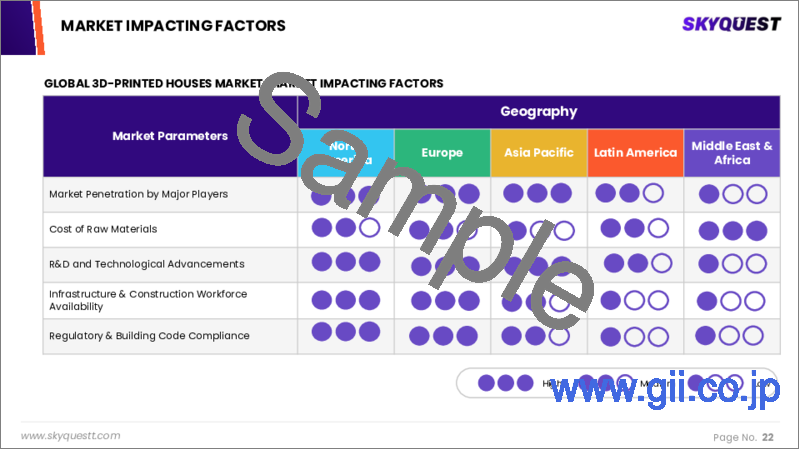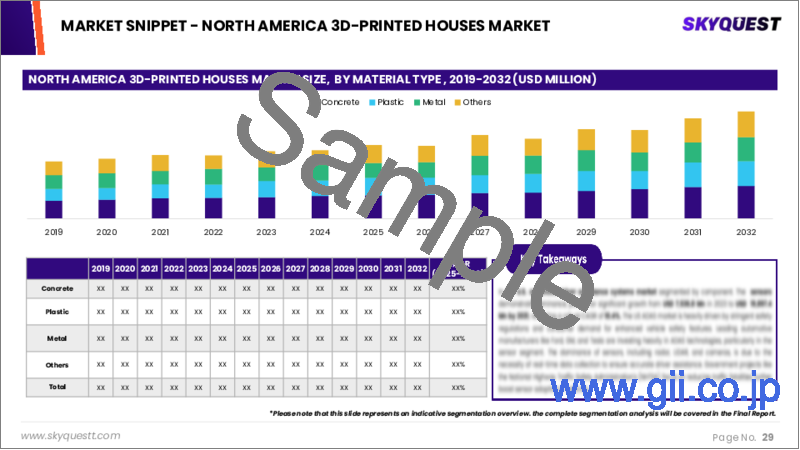|
|
市場調査レポート
商品コード
1640209
3Dプリント住宅の市場規模、シェア、成長分析:材料タイプ別、エンドユーザー別、地域別 - 産業予測、2025年~2032年3D-printed Houses Market Size, Share, Growth Analysis, By Material type (Concrete, Plastic), By End-user (Residential, Commercial), By Region - Industry Forecast 2025-2032 |
||||||
|
|||||||
| 3Dプリント住宅の市場規模、シェア、成長分析:材料タイプ別、エンドユーザー別、地域別 - 産業予測、2025年~2032年 |
|
出版日: 2025年01月21日
発行: SkyQuest
ページ情報: 英文 157 Pages
納期: 3~5営業日
|
全表示
- 概要
- 目次
世界の3Dプリント住宅の市場規模は、2023年に3,690万米ドルとなり、2024年の5,993万米ドルから、2032年までには28億9,935万米ドルに成長し、予測期間(2025年~2032年)のCAGRは62.4%で成長する見通しです。
世界の3Dプリント住宅市場は、最近の技術の進歩と、手頃な価格で持続可能な住宅オプションに対する強い需要に牽引され、急速に台頭しています。3Dプリンティングは建設時間とコストを大幅に削減し、住宅を数カ月ではなく数日で建設できるようにすることで、人件費を削減し、廃棄物を最小限に抑えることができます。さらに、これらの住宅は個々の設計の好みに合わせることができ、多くの場合、環境に優しい材料で建設されるため、持続可能性が高まります。規制上のハードルや初期コストの高さなど、いくつかの課題はあるものの、市場は有望な成長ポテンシャルを示しています。研究開発投資が増加し、この革新的技術の採用が拡大するにつれて、特に北米と欧州で3Dプリント住宅が普及し、世界市場により広く浸透する見込みです。
目次
イントロダクション
- 調査の目的
- 調査範囲
- 定義
調査手法
- 情報調達
- 二次データと一次データの方法
- 市場規模予測
- 市場の前提条件と制限
エグゼクティブサマリー
- 世界市場の見通し
- 供給と需要の動向分析
- セグメント別機会分析
市場力学と見通し
- 市場概要
- 市場規模
- 市場力学
- 促進要因と機会
- 抑制要因と課題
- ポーターの分析
主要な市場の考察
- 主要な成功要因
- 競合の程度
- 主要な投資機会
- 市場エコシステム
- 市場の魅力指数(2024年)
- PESTEL分析
- マクロ経済指標
- バリューチェーン分析
- 価格分析
世界の3Dプリント住宅の市場規模:材料タイプ別・CAGR(2025年~2032年)
- 市場概要
- コンクリート
- プラスチック
- 金属
- その他
世界の3Dプリント住宅の市場規模:エンドユーザー別・CAGR(2025年~2032年)
- 市場概要
- 住宅用
- 商業用
- 産業
世界の3Dプリント住宅の市場規模・CAGR(2025年~2032年)
- 北米
- 米国
- カナダ
- 欧州
- ドイツ
- スペイン
- フランス
- 英国
- イタリア
- その他欧州地域
- アジア太平洋
- 中国
- インド
- 日本
- 韓国
- その他アジア太平洋
- ラテンアメリカ
- ブラジル
- その他ラテンアメリカ地域
- 中東・アフリカ
- GCC諸国
- 南アフリカ
- その他中東・アフリカ
競合情報
- 上位5社の比較
- 主要企業の市場ポジショニング(2024年)
- 主な市場企業が採用した戦略
- 市場の最近の動向
- 企業の市場シェア分析(2024年)
- 主要企業の企業プロファイル
- 会社概要
- 製品ポートフォリオ分析
- 企業のセグメント別シェア分析
- 収益の前年比比較(2022年~2024年)
主要企業プロファイル
- ICON(USA)
- COBOD International(Denmark)
- CyBe Construction(Netherlands)
- Apis Cor(Russia)
- SQ4D Inc.(USA)
- Mighty Buildings(USA)
- WASP(World's Advanced Saving Project)(Italy)
- XtreeE(France)
- Printed Farms(USA)
- Alquist 3D(USA)
- Habitat for Humanity(USA)
- Branch Technology(USA)
- CEMEX(Mexico)
- Sika AG(Switzerland)
- Saint-Gobain(France)
- Winsun(China)
- Dubai Municipality(UAE)
- TU Eindhoven(Netherlands)
- 3D Systems(USA)
- Stratasys(USA)
結論と提言
Global 3D-printed Houses Market size was valued at USD 36.9 million in 2023 and is poised to grow from USD 59.93 million in 2024 to USD 2899.35 million by 2032, growing at a CAGR of 62.4% during the forecast period (2025-2032).
The global 3D-printed houses market is emerging rapidly, driven by recent advancements in technology and a strong demand for affordable, sustainable housing options. 3D printing significantly reduces construction time and costs, allowing homes to be constructed in days rather than months, thereby cutting labor costs and minimizing waste. Furthermore, these homes can be tailored to individual design preferences and are often built with eco-friendly materials, enhancing their sustainability. Despite some challenges, including regulatory hurdles and high initial costs, the market shows promising growth potential. As research and development investment increases and adoption of this innovative technology expands, 3D-printed houses are likely to gain traction, particularly in North America and Europe, with prospects for broader global market penetration.
Top-down and bottom-up approaches were used to estimate and validate the size of the Global 3D-Printed Houses market and to estimate the size of various other dependent submarkets. The research methodology used to estimate the market size includes the following details: The key players in the market were identified through secondary research, and their market shares in the respective regions were determined through primary and secondary research. This entire procedure includes the study of the annual and financial reports of the top market players and extensive interviews for key insights from industry leaders such as CEOs, VPs, directors, and marketing executives. All percentage shares split, and breakdowns were determined using secondary sources and verified through Primary sources. All possible parameters that affect the markets covered in this research study have been accounted for, viewed in extensive detail, verified through primary research, and analyzed to get the final quantitative and qualitative data.
Global 3D-Printed Houses Market Segmental Analysis
Global 3D-printed Houses Market is segmented by Material type, End-user and region. Based on Material type, the market is segmented into Concrete, Plastic, Metal and Others. Based on End-user, the market is segmented into Residential, Commercial and Industrial. Based on region, the market is segmented into North America, Europe, Asia Pacific, Latin America and Middle East & Africa.
Driver of the Global 3D-Printed Houses Market
A major catalyst for the global 3D-printed houses market is the promise of cost-effective and sustainable building solutions. This innovative construction method presents significant advantages over traditional techniques by enabling the construction of homes at reduced costs while utilizing environmentally friendly materials. The efficiency inherent in 3D printing enhances material usage, effectively minimizing waste and further driving down expenses. Furthermore, the reliance on eco-conscious materials resonates well with a growing segment of consumers who prioritize sustainability in their housing choices, making 3D-printed homes an attractive option for those looking to balance affordability with environmental responsibility.
Restraints in the Global 3D-Printed Houses Market
A major challenge hindering the growth of the global 3D-printed houses market is the absence of appropriate building codes and regulations specifically tailored for this innovative construction method. Traditional building codes, which are crucial for guaranteeing safety and maintaining quality standards, often do not account for the distinct characteristics of 3D-printed structures. Consequently, there is an urgent need to formulate new guidelines that effectively address 3D printing technologies in the construction sector. However, the lengthy process of developing and enacting these regulations can impede market expansion, delaying the widespread acceptance and implementation of 3D-printed housing solutions.
Market Trends of the Global 3D-Printed Houses Market
The global 3D-printed houses market is witnessing a significant trend towards the adoption of sustainable construction practices, driven by escalating environmental concerns and a collective shift towards eco-friendly solutions. 3D printing technology enables precise material usage, significantly minimizing waste and enhancing construction efficiency. This innovative approach often incorporates sustainable materials, including recycled plastics and alternative concrete options, which collectively reduce the carbon footprint associated with traditional building methods. As stakeholders increasingly prioritize sustainability, this trend not only promises to revolutionize residential construction but also aligns with broader efforts to combat climate change, positioning 3D printing as a crucial player in the future of sustainable architecture.
Table of Contents
Introduction
- Objectives of the Study
- Scope of the Report
- Definitions
Research Methodology
- Information Procurement
- Secondary & Primary Data Methods
- Market Size Estimation
- Market Assumptions & Limitations
Executive Summary
- Global Market Outlook
- Supply & Demand Trend Analysis
- Segmental Opportunity Analysis
Market Dynamics & Outlook
- Market Overview
- Market Size
- Market Dynamics
- Drivers & Opportunities
- Restraints & Challenges
- Porters Analysis
- Competitive rivalry
- Threat of substitute
- Bargaining power of buyers
- Threat of new entrants
- Bargaining power of suppliers
Key Market Insights
- Key Success Factors
- Degree of Competition
- Top Investment Pockets
- Market Ecosystem
- Market Attractiveness Index, 2024
- PESTEL Analysis
- Macro-Economic Indicators
- Value Chain Analysis
- Pricing Analysis
Global 3D-printed Houses Market Size by Material type & CAGR (2025-2032)
- Market Overview
- Concrete
- Plastic
- Metal
- Others
Global 3D-printed Houses Market Size by End-user & CAGR (2025-2032)
- Market Overview
- Residential
- Commercial
- Industrial
Global 3D-printed Houses Market Size & CAGR (2025-2032)
- North America (Material type, End-user)
- US
- Canada
- Europe (Material type, End-user)
- Germany
- Spain
- France
- UK
- Italy
- Rest of Europe
- Asia Pacific (Material type, End-user)
- China
- India
- Japan
- South Korea
- Rest of Asia-Pacific
- Latin America (Material type, End-user)
- Brazil
- Rest of Latin America
- Middle East & Africa (Material type, End-user)
- GCC Countries
- South Africa
- Rest of Middle East & Africa
Competitive Intelligence
- Top 5 Player Comparison
- Market Positioning of Key Players, 2024
- Strategies Adopted by Key Market Players
- Recent Developments in the Market
- Company Market Share Analysis, 2024
- Company Profiles of All Key Players
- Company Details
- Product Portfolio Analysis
- Company's Segmental Share Analysis
- Revenue Y-O-Y Comparison (2022-2024)
Key Company Profiles
- ICON (USA)
- Company Overview
- Business Segment Overview
- Financial Updates
- Key Developments
- COBOD International (Denmark)
- Company Overview
- Business Segment Overview
- Financial Updates
- Key Developments
- CyBe Construction (Netherlands)
- Company Overview
- Business Segment Overview
- Financial Updates
- Key Developments
- Apis Cor (Russia)
- Company Overview
- Business Segment Overview
- Financial Updates
- Key Developments
- SQ4D Inc. (USA)
- Company Overview
- Business Segment Overview
- Financial Updates
- Key Developments
- Mighty Buildings (USA)
- Company Overview
- Business Segment Overview
- Financial Updates
- Key Developments
- WASP (World's Advanced Saving Project) (Italy)
- Company Overview
- Business Segment Overview
- Financial Updates
- Key Developments
- XtreeE (France)
- Company Overview
- Business Segment Overview
- Financial Updates
- Key Developments
- Printed Farms (USA)
- Company Overview
- Business Segment Overview
- Financial Updates
- Key Developments
- Alquist 3D (USA)
- Company Overview
- Business Segment Overview
- Financial Updates
- Key Developments
- Habitat for Humanity (USA)
- Company Overview
- Business Segment Overview
- Financial Updates
- Key Developments
- Branch Technology (USA)
- Company Overview
- Business Segment Overview
- Financial Updates
- Key Developments
- CEMEX (Mexico)
- Company Overview
- Business Segment Overview
- Financial Updates
- Key Developments
- Sika AG (Switzerland)
- Company Overview
- Business Segment Overview
- Financial Updates
- Key Developments
- Saint-Gobain (France)
- Company Overview
- Business Segment Overview
- Financial Updates
- Key Developments
- Winsun (China)
- Company Overview
- Business Segment Overview
- Financial Updates
- Key Developments
- Dubai Municipality (UAE)
- Company Overview
- Business Segment Overview
- Financial Updates
- Key Developments
- TU Eindhoven (Netherlands)
- Company Overview
- Business Segment Overview
- Financial Updates
- Key Developments
- 3D Systems (USA)
- Company Overview
- Business Segment Overview
- Financial Updates
- Key Developments
- Stratasys (USA)
- Company Overview
- Business Segment Overview
- Financial Updates
- Key Developments






